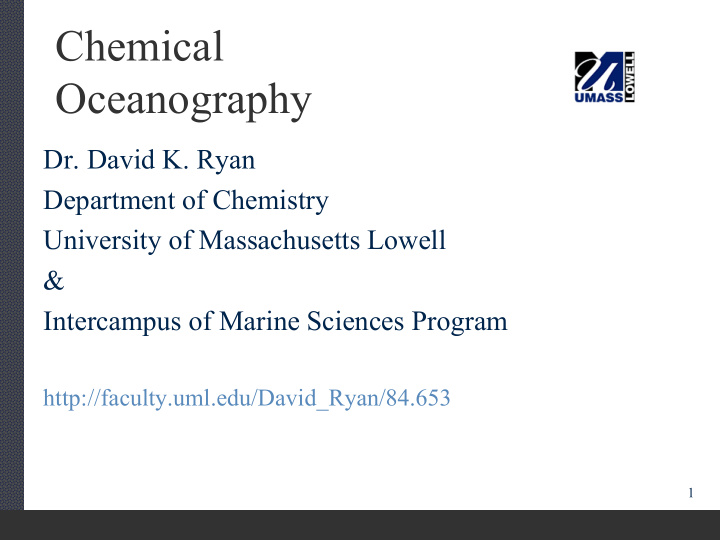



Chemical Oceanography Dr. David K. Ryan Department of Chemistry University of Massachusetts Lowell & Intercampus of Marine Sciences Program http://faculty.uml.edu/David_Ryan/84.653 1
Website of interest Re: H 2 O www.biology.arizona.edu/biochemistry/tutorials/c hemistry/page3.html These websites appear to have accurate information, however it is impossible for me to verify details or guarantee availability. 2
Website for Millero 2013 http://fig.cox.miami.edu/~lfarmer/MSC215/MSC215 .HTM Monterey Bay Aquarium Research Institute (MBARI) www.mbari.org/chemsensor/pteo.htm 3
Water – Amazing Stuff 4
Chemical Oceanography Physical Chemistry of Seawater (E&H Chap. 3) Seawater is 96.5 % H 2 O Water unique substance & solvent Review structure Discuss selected unusual properties Consequences of water anomalies Phase diagrams 5
Molecular Structure of H 2 O Electron Space Filling “Ball & Stick” Density Model Model Distribution 6
Periodic Table of the Elements Rows = Periods Columns = Groups or Families 7
Zoom in on O and its neighbors Part of one period Each can form compounds with hydrogen 8
Boiling Point Comparison Figure 3.2 in Emerson & Hedges 9
Look at O and its relatives Outer shell electronic Configuration is the same Group or Family 6A 10
Boiling Point Comparison Figure 3.2 in Emerson & Hedges 11
Hydrogen Bonding is key to anomalous properties of water H-Bonding results from polarity 12
Dipole & Quadrapole Diagrams (Millero 2006) p. 125 13
Water dipole & quadrapole Oxygen is shown in red, Hydrogen is shown in gray & Electrons are depicted as yellow 14
Yet another representation 15
Water Tetrahedron The two non-bonded pairs of electrons on oxygen form the back two legs of the tetrahedron, but are not shown 16
17 Arrangement for Hydrogen Bonding - Pentamer
Hydrogen bonding in liquid water is always present However, H-bonds are constantly forming and breaking It is a dynamic process that can be represented or modeled in several ways See Millero (3 rd ed) p 128–132 for models 18
Water Clusters Dynamically Form, Break and Re-form Frank & Wen Flickering Cluster Model 19 (Millero 2006)
Millero 20
Water Properties High Heat Capacity (C p ) (Heat energy to raise 1 g of water 1 o C) Prevents extreme ranges of temperature (temp buffering) Allows heat transfer by water masses to be large 21
Water Properties High Heat of Fusion ( ∆ H = 79 cal/g) (Heat energy for melting solid) Absorption or release of latent heat results in high thermostatic effect a.k.a. Enthalpy of Fusion (kJ/kg) 22
Water Properties High Heat of Vaporization ( ∆ H = 540 cal/g) (Heat energy for evaporating liquid) Highest of all liquids Results in evaporative cooling and transfer of heat to atmosphere, thermostating a.k.a. Enthalpy of Vaporization 23
Large Quantities of Heat are Absorbed & Released During Phase Changes 24 (Wiley 1999)
Water Properties Thermal Expansion (temperature of maximum density) Waters with low or no salt content have maximum density above freezing points Ice floats 25
Simple Phase Diagram of Water (Wiley 1999) 26
Water Properties High Dielectric Constant (highest of almost all substances) Results in charge insulating power Important in dissolution of salts Important in hydration of ions 27
Water Properties Relatively High Viscosity (high for low molecular weight substance) Important in wave and current formation 28
Water Properties High Surface Tension (highest of all substances) Controls drop formation, important in waves and many surface properties Important in cell physiology 29
Interfacial Tension creates appearance of a “skin” on surface 30
Recommend
More recommend